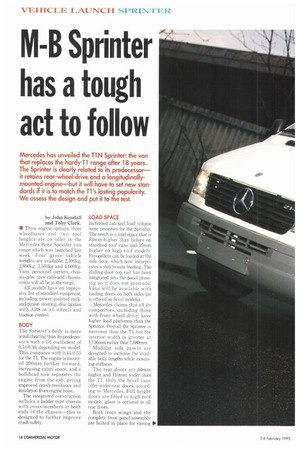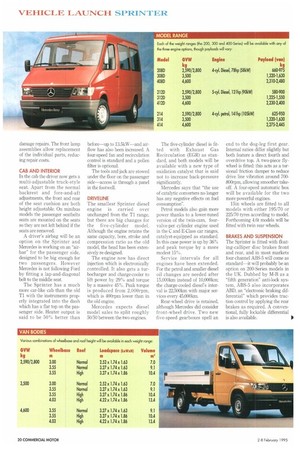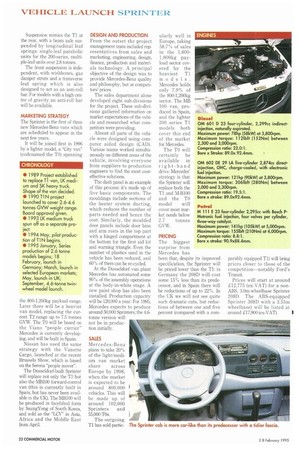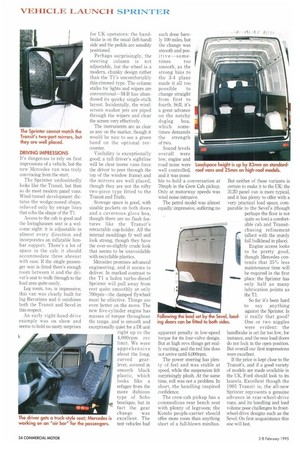NI-B Sprinter has a tough act to follow
Page 20

Page 22

Page 24

Page 26

If you've noticed an error in this article please click here to report it so we can fix it.
Mercedes has unveiled the Ti N Sprinter: the van that replaces the hardy Ti range after 18 years. The Sprinter is clearly related to its predecessor— it retains rear-wheel-drive and a longitudinallymounted engine—but it will have to set new standards if it is to match the Ti's lasting popularity. We assess the design and put it to the test.
by John Kendall and Toby Clark.
• Three engine options, three wheelbases and two roof heights are on offer in the Mercedes-Benz Sprinter van range which was launched last week. Four gross vehicle weights are available; 2,590kg, 2,800kg, 3,500kg and 4,600kg. Vans, personnel carriers, chassis-cabs. crew-cabs and chassiscowls will all be in the range.
All models have an impressive list of standard equipment, including power assisted rackand-pinion steering, disc brakes with ABS on all wheels and traction control.
BODY The Sprinter's body is more wind cheating than its predecessor's with a Cd coefficient of 0.34-0.36, depending on model. This compares with 0.44-0.55 for the Ti. The engine is mounted 290mm further forward, increasing cabin space, and a bulkhead now separates the engine from the cab, giving improved crash resistance and insulation from engine noise.
The integrated construction includes a ladder-type chassis with cross-members at both ends of the chassis—this is designed to further improve crash safety. LOAD SPACE Increased cab and load volume were priorities for the Sprinter. The result is a load space that is 83mm higher than before on standard roof vans and 25mm higher on high-roof models. Europa!lets can be loaded at the side door, which now incorporates a step to ease loading. The sliding-door top rail has been integrated into the panel pressing so it does not protrude. Vans will be available with loading doors on both sides (as is offered on Sevel models).
Mercedes claims that all its competitors, including those with front-wheel drive, have higher load platforms than the Sprinter. Overall the Sprinter is narrower than the Ti but the interior width is greater at 1,736mm rather than 1,680mm.
Modular side panels are designed to increase the available body lengths while increasing stiffness.
The rear doors are 60inin higher and 110mm wider than the Ti. Only the Sevel vans offer wider rear doors, according to Mercedes. Full-height doors are fitted to high roof models; glass is optional in all rear doors.
Both front wings and the complete front panel assembly are bolted in place for easing damage repairs. The front lamp assemblies allow replacement of the individual parts, reducing repair costs.
CAB AND INTERIOR
In the cab the driver now gets a multi-adjustable truck-style seat. Apart from the normal backrest and fore-and-aft adjustments, the front and rear of the seat cushion are both height adjustable. On minibus models the passenger seatbelts seats are mounted on the seats so they are not left behind if the seats are removed.
A driver's airbag will be an option on the Sprinter and Mercedes is working on an "airbar" for the passenger side, designed to be big enough for two passengers. However Mercedes is not following Ford by fitting a lap-and-diagonal belt to the middle seat.
The Sprinter has a much more car-like cab than the old Ti with the instruments properly integrated into the dash which has a flat top on the passenger side. Heater output is said to be 50% better than before-up to 13.5kW-and airflow has also been increased. A four-speed fan and recirculation control is standard and a pollen filter is optional.
The tools and jack are stowed under the floor on the passenger side-access is through a panel in the footwell.
DRIVELINE
The smallest Sprinter diesel engine is carried over unchanged from the Ti range, but there are big changes for the five-cylinder model. Although the engine retains the same capacity, bore, stroke and compression ratio as the old model, the head has been extensively re-designed.
The engine now has direct injection which is electronically controlled. It also gets a turbocharger and charge-cooler to lift power by 29% and torque by a massive 45%. Peak torque is produced from 2,000rpm, which is 400rpm lower than in the old engine.
Mercedes expects diesel model sales to split roughly 50/50 between the two engines. The five-cylinder diesel is fitted with Exhaust Gas Recirculation (EGR) as standard, and both models will be available with a new type of oxidation catalyst that is said not to increase back-pressure significantly.
Mercedes says that the use of catalytic converters no longer has any negative effects on fuel consumption".
Petrol models also gain more power thanks to a lower-tuned version of the twin-cam, fourvalve-per cylinder engine used in the C and E-Class car ranges, catalyst-equipped as standard. In this case power is up by 36% and peak torque by a more modest 15%.
Service intervals for all engines have been extended. For the petrol and smaller diesel oil changes are needed after 15,000km instead of 10,000km; the charge-cooled diesel's interval is 22,500km with major services every 45,000km.
Rear-wheel drive is retained, although Mercedes did consider front-wheel drive. Two new five-speed gearboxes spell an end to the dog-leg first gear. Internal ratios differ slightly but both feature a direct fourth and overdrive top. A two-piece flywheel is fitted: this acts as a torsional friction damper to reduce drive line vibration around 70080Orpm, allowing smoother takeoff. A four-speed automatic box will be available for the two more powerful engines.
15in wheels are fitted to all models with either 195/70 or 225/70 tyres according to model. Forthcoming 4.6t models will be fitted with twin rear wheels.
BRAKES AND SUSPENSION
The Sprinter is fitted with floating-calliper disc brakes front and rear, and in most markets four-channel ABS-5 will come as standard-it will probably be an option on 200-Series models in the UK. Dubbed by M-B as a "fifth generation" anti-lock system, ABS-5 also incorporates ABD, an "electronic braking differential" which provides traction control by applying the rear brakes as required. A conventional, fully lockable differential is also available. 1111 Suspension mimics the Ti at the rear, with a beam axle suspended by longitudinal leaf springs: single-leaf parabolic units for the 200-series, multiple-leaf units over 2.8 tonnes.
The front suspension is independent, with wishbones. gas damper struts and a transverse leaf spring which is also designed to act as an anti-roll bar. For models with a high centre of gravity an anti-roll bar will be available.
MARKETING STRATEGY The Sprinter is the first of three new Mercedes-Benz vans which are scheduled to appear in the next few years.
It will be joined first in 1996 by a lighter model, a "City van" (codenamed the TO) spanning the 800-1,200kg payload range. Later there will be a heavier van model, replacing the current 12 range up to 7.5 tonnes GVW. The TO will be based on the Viano "people carrier" Mercedes is currently developing, and will be built in Spain.
Nissan has used the same strategy with the Vanette Cargo, launched at the recent Brussels Show, which is based on the Serena "people mover".
The Dusseldorf-built Sprinter will replace not only the T1 but also the MB100 forward-control van (this is currently built in Spain, but has never been available in the UK). The MB100 will be produced in facelifted form by SsangYong of South Korea, and sold as the "LCV" in Asia, Africa and the Middle East from April. DESIGN AND PRODUCTION From the outset the project management team included representatives from sales and marketing, engineering, design, finance, production and materials technology. A principal objective of the design was to provide Mercedes-Benz quality and philosophy, but at competitors' prices.
The sales department alone developed eight sub-divisions for the project. These sub-divisions gathered information on market expectations of the vehicle and researched what competitors were providing.
Almost all parts of the vehicle were designed using computer aided design (CAD). Various teams worked simultaneously on different areas of the vehicle, involving everyone from suppliers to production engineers to find the most costeffective solutions.
The dash panel is an example of this process: it's made up of five basic components. The mouldings include sections of the heater system ducting, which reduces the number of parts needed and hence the cost. Similarly, the moulded door panels include door bins and arm rests in the top part with a hinged compartment at the bottom for the first aid kit and warning triangle. Even the number of plastics used in the vehicle has been reduced, and 60% of them can be re-cycled.
At the Dusseldorf van plant Mercedes has automated some 90% of the assembly operations at the body-in-white stage. A new paint shop has also been installed. Production capacity will be 120,000 a year. For 1995, Mercedes expects to produce around 50,0130 Sprinters; the 4.6tonne version will not be in production initially.
SALES Mercedes-Benz plans to take 20% of the light/medium van market share across Europe by 1998, when the market is expected to be around 800,000 vehicles. This will be made up of around 102,000 Sprinters and 55,000 TOs.
The outgoing Ti has sold partic
ularly well in Europe, taking 58.7% of sales in the 1,6001,800kg payload sector covered by the heaviest T1 models. Mercedes holds only 7.9% of the 800-1,200kg sector. The MB 100 van, produced in Spain, and the lighter 200 series Ti models both cover this end of the market for Mercedes.
The TO will certainly be available in right-hand drive. Mercedes' strategy is that the Sprinter will replace both the T1 and M-B100 and the TO model will cover most market needs below 2.7 tonnes GVW.
PRICING
The biggest surprise from Mercedes has been that, despite its improved specification, the Sprinter will be priced lower than the Ti: in Germany the 208D will cost some 15% less than its predecessor, and in Spain there will be reductions of up to 22%. In the UK we will not see quite such dramatic cuts, but reductions of between one and five percent (compared with a corn
parably equipped Ti) will bring prices closer to those of the competition—notably Ford's Transit.
Prices will start at around £12,775 (ex-VAT) for a nonABS, 3.0m-wheelbase Sprinter 2081). The ABS-equipped Sprinter 308D with a 3.55m wheelbase) will be listed at around £17,900 (ex-VAT). DRIVING IMPRESSIONS It's dangerous to rely on first impressions of a vehicle, but the new Mercedes van was truly convincing from the start.
The Sprinter undoubtedly looks like the Transit. but then so do most modern panel vans. Wind-tunnel development dictates the wedge-nosed shape, relieved only by swage lines that echo the shape of the Ti.
Access to the cab is good and the Isringhausen seat is a welcome sight: it is adjustable in almost every direction and incorporates an inflatable lumbar support. There's a lot of space in the cab: it should accommodate three abreast with ease. If the single passenger seat is fitted there's enough room between it and the driver's seat to walk through to the load area quite easily.
Leg room, too, is impressive; this van was clearly built for big Bavarians and it outshines both the Transit and Sevel in this respect.
An early right-hand-drive example was on show and seems to hold no nasty surprises for UK operators: the handbrake is on the usual (left-hand) side and the pedals are sensibly positioned.
Perhaps surprisingly, the steering column is not adjustable, but the wheel is a modern, chunky design rather than the Ti's uncomfortably thin-rimmed type. The column stalks for lights and wipers are conventional—M-B has abandoned its quirky single-stalk layout. Incidentally, the windscreen washer jets are piped through the wipers and clear the screen very effectively.
The instruments are as clear as any on the market, though it would be nice to see a green band on the optional revcounter.
Visibility is exceptionally good; a tall driver's sightline will be clear (some vans force the driver to peer through the top of the window frame) and the mirrors are well placed, though they are not the nifty two-piece type fitted to the Transit and Trafic.
Stowage space is good, with sizable pockets on both doors and a cavernous glove box, though there are no flash features like the Transit's retractable cup-holder. All the internal mouldings fit well and look strong, though they have the ever-so-slightly crude look that seems to be unavoidable with recyclable plastics.
Mercedes promises advanced engineering, and it seems to deliver. In marked contrast to the T1 a laden turbo-diesel Sprinter will pull away from rest quite smoothly at only 700rpm—the damped flywheel must be effective. Things are even better on the move. The new five-cylinder engine has masses of torque throughout the range, and is smooth and exceptionally quiet for a DI unit right up to the 4,000rpm rev limit. We were apprehensive about the long, curved gearlever, covered in smooth black plastic, which looks like a refugee from the more dubious type of Soho boutique, but in fact the gear change was excellent. The test vehicles had
each done barely 100 miles, but the change was smooth and positive—some
times too smooth, as the strong bias to the 3-4 plane made it all too possible to change straight from first to fourth. Still, it's a great advance on the notchy dogleg box, which sometimes demands the strength of two.
Sound levels overall were low; engine and road noise were well controlled, and it was possible to hold a conversation at 70mph in the Crew Cab pickup. Only at motorway speeds was wind noise intrusive.
The petrol model was almost equally impressive, suffering no apparent penalty in low-speed torque for its four-valve design. But at high revs things get really exciting, and the red line does not arrive until 6,000rpm.
The power steering has plenty of feel and was stable at speed, while the suspension felt surprisingly plush. At the same time, roll was not a problem. In short, the handling inspired confidence.
The crew-cab pickup has a commodious rear bench seat with plenty of legroom; the Kombi people-carrier should offer more room than anything short of a full-blown minibus. But neither of these variants is certain to make it to the UK: the 3I2D panel van is more typical, and it has plenty to offer with a very practical load space, comparable to the Sevel's (though perhaps the floor is not quite so low) a comfortable cab and Transitchasing refinement (albeit with the sturdy full bulkhead in place).
Engine access looks to be pretty good, though Mercedes contends that 35% less maintenance time will be required in the first place: the Sprinter has only half as many lubrication points as the Ti.
So far it's been hard to say anything against the Sprinter. Is it really that good? One or two niggles were evident: the handbrake is set far too low, for instance, and the rear load doors do not lock in the open position. But overall our first impressions were excellent.
If the price is kept close to the Transit's, and if a good variety of models are made available in the UK, Ford should look to its laurels. Excellent though the 1995 Transit is, the all-new Sprinter represents a genuine advance in rear-wheel-drive vans, and its handling and load volume pose challenges to frontwheel-drive designs such as the Sevel. On first acquaintance this one will last.
































































































